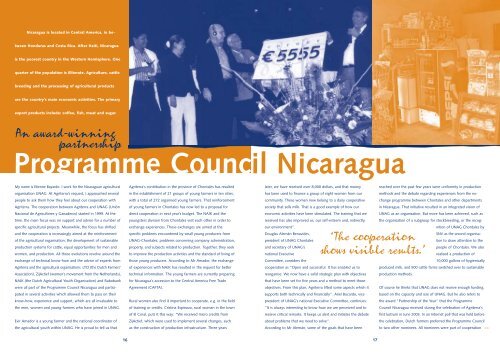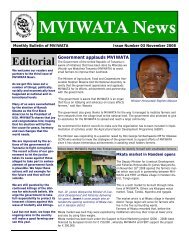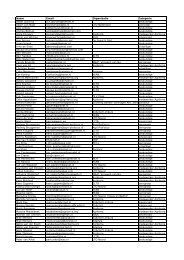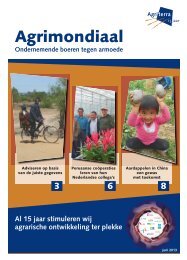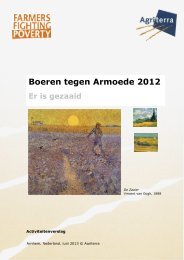Nicaragua is located in Central America, in betweenHonduras and Costa Rica. After Haiti, Nicaraguais the poorest country in the Western Hemisphere. Onequarter of the population is illiterate. Agriculture, cattlebreeding and the processing of agricultural productsare the country’s main economic activities. The primaryexport products include: coffee, fish, meat and sugar.An award-winningpartnershipProgramme Council NicaraguaMy name is Etienne Bayardo. I work for the Nicaraguan agriculturalorganisation UNAG. At <strong>Agriterra</strong>’s request, I approached severalpeople to ask them how they feel about our cooperation with<strong>Agriterra</strong>. The cooperation between <strong>Agriterra</strong> and UNAG (UniónNacional de Agricultores y Ganaderos) started in 1999. At thetime, the main focus was on support and advice for a number ofspecific agricultural projects. Meanwhile, the focus has shiftedand the cooperation is increasingly aimed at the reinforcementof the agricultural organisation, the development of sustainableproduction systems for cattle, equal opportunities for men andwomen, and production. All those evolutions revolve around theexchange of technical know-how and the advice of experts from<strong>Agriterra</strong> and the agricultural organisations. LTO (the Dutch Farmers’Association), ZijActief (women’s movement from the Netherlands),NAJK (the Dutch Agricultural Youth Organisation) and Rabobankwere all part of the Programme Council Nicaragua and participatedin several activities which allowed them to pass on theirknow-how, experience and support, which are all invaluable tothe men, women and young farmers who have joined in UNAG.Evir Amador is a young farmer and the national coordinator ofthe agricultural youth within UNAG. He is proud to tell us that<strong>Agriterra</strong>’s contribution in the province of Chontales has resultedin the establishment of 21 groups of young farmers in ten cities,with a total of 272 organised young farmers. That reinforcementof young farmers in Chontales has now led to a proposal fordirect cooperation in next year’s budget. The NAJK and theyoungsters division from Chontales visit each other in order toexchange experiences. Those exchanges are aimed at thespecific problems encountered by small young producers fromUNAG-Chontales, problems concerning company administration,property, and subjects related to production. Together, they seekto improve the production activities and the standard of living ofthose young producers. According to Mr Amador, the exchangeof experiences with NAJK has resulted in the request for bettertechnical information. The young farmers are currently preparingfor Nicaragua’s accession to the Central America Free TradeAgreement (CAFTA).Rural women also find it important to cooperate, e.g. in the fieldof training or credits. Cristina Espinoza, rural woman in the townof El Coral, puts it this way: "We received micro credits fromZijActief, which were used to implement several changes, suchas the construction of production infrastructure. Three yearslater, we have received over 8,000 dollars, and that moneyhas been used to finance a group of eight women from ourcommunity. These women now belong to a dairy cooperativesociety that sells milk. That is a good example of how oureconomic activities have been stimulated. The training that wereceived has also improved us, our self-esteem and, indirectly,our environment".Douglas Alemán Benavides,president of UNAG Chontalesand secretary of UNAG’snational ExecutiveCommittee, considers thecooperation as "Open and successful. It has enabled us toreorganise. We now have a solid strategic plan with objectivesthat have been set for five years and a method to meet thoseobjectives. From this plan, <strong>Agriterra</strong> lifted some aspects which itsupports both technically and financially". Ariel Bucardo, vicepresident of UNAG’s national Executive Committee, continues:"It is always interesting to know how we are perceived and toreceive critical remarks. It keeps us alert and initiates the debateabout problems that we need to solve".According to Mr Alemán, some of the goals that have been‘The cooperationshows visible results.’reached over the past few years were uniformity in productionmethods and the debate regarding experiences from the exchangeprogramme between Chontales and other departmentsin Nicaragua. That initiative resulted in an integrated vision ofUNAG as an organisation. But more has been achieved, such asthe organisation of a subgroup for stockbreeding, or the recognitionof UNAG Chontales bySNV as the second organisationto draw attention to thepeople of Chontales. We alsorealised a production of10,000 gallons of hygienicallyproduced milk, and 500 cattle farms switched over to sustainableproduction methods.Of course he thinks that UNAG does not receive enough funding,based on the capacity and size of UNAG. But he also refers tothe award "Partnership of the Year" that the ProgrammeCouncil Nicaragua received during the celebration of <strong>Agriterra</strong>’sfirst lustrum in June 2003. In an Internet poll that was held beforethe celebration, Dutch farmers preferred the Programme Councilto two other nominees. All nominees were part of cooperation >>1617
ogramme CouncilNicaragua>> agreements between rural organisations in developing countriesand in the Netherlands. Encouraged by winning this award,Mr Alemán hopes that the cooperation agreement with UNAGwill be redefined.Volunteers make the most of their talentsAfter several positive experiences from the past, <strong>Agriterra</strong> has again started to actively recruit volunteersfor big and small tasks at our office in Arnhem. Every week, an average of five volunteers work for one day each.They interview experts who have just returned from a mission, write articles for the website, keep the countries’site updated or accompany our guests from abroad. But why do they choose to work for <strong>Agriterra</strong> as volunteers,and what does that mean to <strong>Agriterra</strong>?We asked some (former) volunteers why they wanted to work for <strong>Agriterra</strong>. Cultural anthropologist Olga van der Valk, volunteer in2003, explains us why: "I feel at ease in dealing with people from the agricultural sector, both in the Netherlands and in developingcountries. I enjoy working with farmers, and that is what distinguishes <strong>Agriterra</strong> from other development organisations"."The fun part about working as a volunteer for <strong>Agriterra</strong> is that there are so many subjects that you can deal with. Once you arefamiliar with the way everything works, you get plenty of opportunities to suggest ideas of your own and to implement them", saysWebmaster and musician Jan Willem Welink, volunteer since October 2003. "It is partly due to my work as a volunteer for <strong>Agriterra</strong>that I got my current job last year", says biologist Anne Rottink, the first person to work forAnd <strong>Agriterra</strong> isconstantly on thelookout for volunteerswith a ‘green heart’.Check our websitefor vacancies.the solid reputation and recognition of the Rural Savings Bankin the province of Chontales. Blanca Lidia Suárez, manager ofthe Rural Savings Bank, describes the cooperation within theprogramme council as "excellent", but at the same time sheasks that the intermediary bank BANCENTRO, the private bankThe Rural Savings Bank (Cooperativa de Ahorro y Crédito CajaRural Regional), a credit cooperative society that is closely linkedto UNAG Chontales, was recently declared the institution inChontales that best manages financial means. That certificationthat transfers the financial means, be left out, given the fact thatthe procedure increases the operational cost and thus forces theRural Savings Bank to charge higher rates for the credits of itsmembers.and solid reputation is owed to the devotion of the members,management and the administrative staff. I had the opportunityto attend a member’s meeting, where I witnessed the extent oftheir involvement in taking decisions on behalf of the cooperativesociety. It was a fine example of development, professionalismand democracy.The technical assistance and the financial aid that RabobankThe cooperation with UNAG in Nicaragua shows visible results,not just in financial aid, but mostly in the close cooperationbetween experts from the Netherlands and representatives fromUNAG and the Cooperative Rural Savings Bank. And since ourtheme is ‘A matter of cooperation’, I would like to cite thisinitiative as an example of a project that deserves to be continuedprovided for the institutional reinforcement have contributed to and expanded.■<strong>Agriterra</strong> as a volunteer, in October 2002.The different reactions from the volunteers show that they feel at home at <strong>Agriterra</strong>: "The colleaguesat <strong>Agriterra</strong> really made me feel like I was one of them" (Anne Rottink), "Volunteers are takenseriously. People respond quickly to your questions and they help you to solve problems" (DirkRuijne), "At <strong>Agriterra</strong>, I felt like a journalist, which I really enjoyed." (Marloes Muller).It is clear to all: the enthusiasm, the know-how and the skills of our volunteers are an importantcontribution to <strong>Agriterra</strong>’s activities, and it is a two-way street. Volunteers can make the most of their talents and gain experience,while <strong>Agriterra</strong> can organise more activities for and together with the organisations in the Netherlands, despite a limited budget.This publication was also mainly written by volunteers!■WomenworldwideWhile maintaining their own identity andreligion, four Dutch women’s organisations cooperateto obtain worldwide sustainable development.Their themes are water, food worldwide and organisationreinforcement. 4VO is a rural cooperationlinkage between NBvP - Vrouwen van Nu (DutchRural Women’s Union - Women of Today), Passage(Christian Social Women’s Movement), the CatholicWomen’s Organisation and ZijActief Nederland,catholic women’s network.Rural women inspire each other, they develop and voice jointviews, they learn from each other’s projects and methods. Incooperating, the organisations wish to enhance their members’involvement in international cooperation. According to InekeLudikhuize, director of Passage and member of <strong>Agriterra</strong>’s Boardon behalf of 4VO, they are setting a good example. Why wouldone look across the borders for international cooperation, and notdo so in their own rural women’s organisation in the Netherlands?4VO represents a total of 150,000 members, which makes iteasier to protect its interests, here and in the rest of the world.4VO stays well-informed about what’s going on, both on anational and an international level. The members attend seminarsand congresses, and they exchange the information that is obtainedamongst themselves. The importance of the support for women’sorganisations and projects for women in developing countries isbrought to the attention of third parties involved, e.g. for financialsupport. At the moment, the organisations work together withpartner organisations in Benin, Costa Rica, Sierra Leone, Nicaragua,Burkina Faso and the Philippines.At the end of 2003, 4VO submitted the project "SustainableDevelopment Worldwide" to NCDO, the National Commissionfor International Cooperation and Sustainable Development.<strong>Agriterra</strong> supports and guides the project group. The basic idea isthat 4VO gives its members concrete performance perspectives todevote themselves to the project. They gain insights and are ableto express their views on Sustainable Development Worldwidefrom a gender perspective point of view. Gender is considered tobe the importance that society attributes to the mutual relationsbetween men and women. Women often have less rights andresponsibilities, as well as limited access to productive naturalresources and opportunities such as education and training,credit, capital and land. It is therefore important to make sure thatthe opportunities and advantages are distributed equally amongwomen and men, and that gender inequality is reduced.In consultation with its members and partner organisations,4VO phrases its views and voices them on both a national andinternational level. The media are actively approached, concreteresults are made public and 4VO participates in public eventsand gatherings.Next to 4VO, <strong>Agriterra</strong> also supports South-South cooperationefforts between women’s organisations and women’s commissions.The analysis of the economic role and contribution of bothwomen and men clearly shows that success will only be guaranteedif women, as well as men, are actively involved in all the levelsof organisation and execution. José Levelink, monitoring &evaluation officer, concludes in her evaluation study that withinthe projects of <strong>Agriterra</strong> still not enough attention is given to thewomen’s interests. For example women take part in trainingprogrammes but the training is not based on their needs. In itsprogramme 2004-2006, <strong>Agriterra</strong> will check the gender aspectof each of the projects. At the beginning of each ‘reinforcementroute’ we will assess the position of women and the concern forwomen and gender. That will be the point of departure to definethe organisation’s gender policy and to come to equal relationsbetween men and women.■1819


